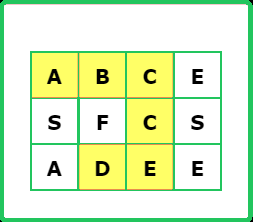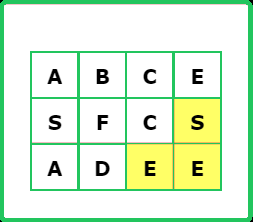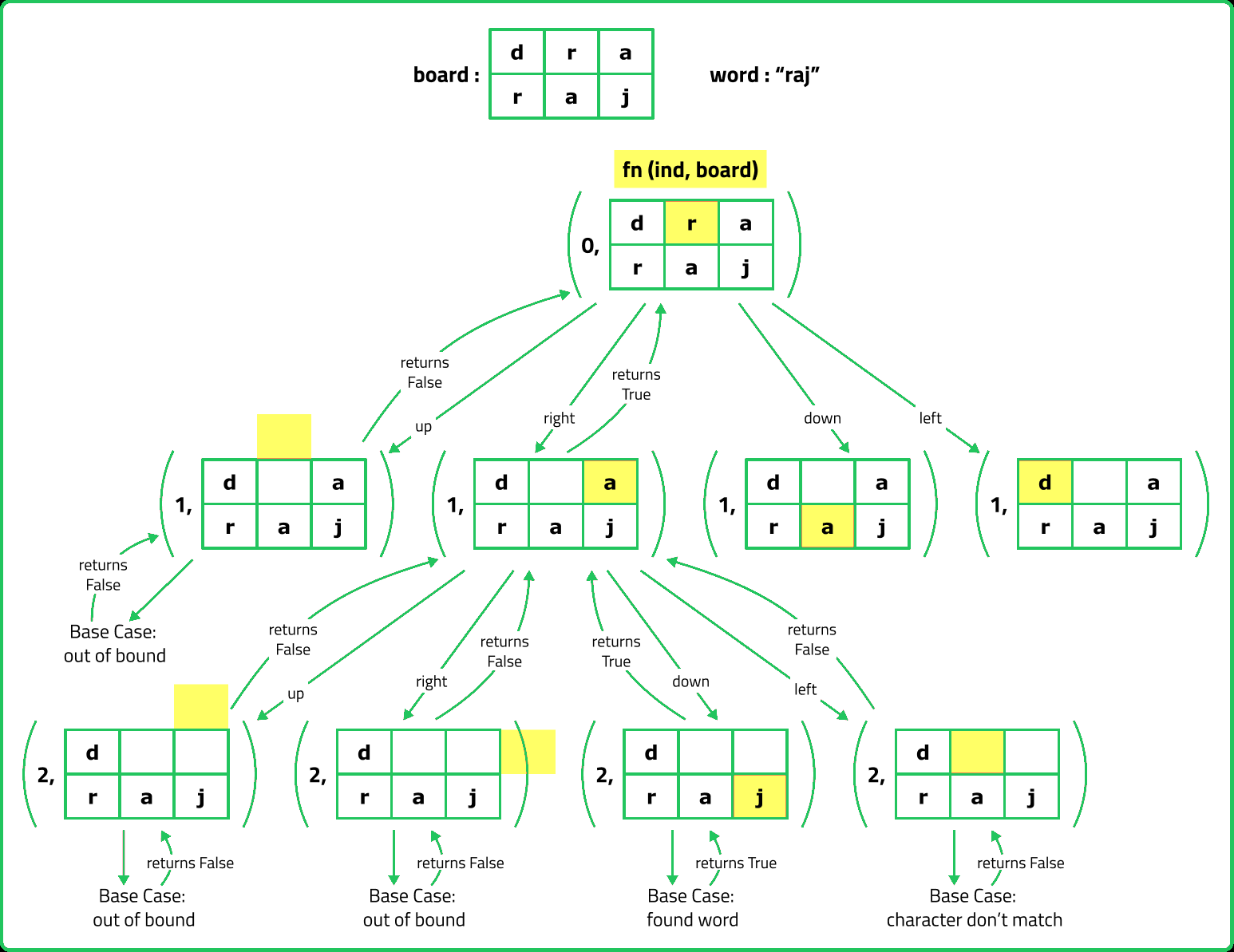12345678910111213141516171819202122232425262728293031323334353637383940414243444546474849505152535455565758596061626364656667686970717273
#include<bits/stdc++.h>
using namespace std;
class Solution {
public:
// Helper function to check if the word exists starting from cell (i, j)
bool func(vector<vector<char> > & v, int i, int j, string& s, int k) {
// If all characters of the word are found
if (k == s.length()) {
return true;
}
// Boundary conditions and character mismatch check
if (i < 0 || j < 0 || i >= v.size() || j >= v[0].size() || s[k] != v[i][j]) {
return false;
}
// Initialize answer as false
bool ans = false;
// Temporarily mark the cell as visited
char x = v[i][j];
v[i][j] = ' ';
// Check all four possible directions (down, up, right, left)
ans |= func(v, i + 1, j, s, k + 1);
ans |= func(v, i - 1, j, s, k + 1);
ans |= func(v, i, j + 1, s, k + 1);
ans |= func(v, i, j - 1, s, k + 1);
// Restore the original character in the cell
v[i][j] = x;
return ans;
}
// Main function to check if the word exists in the board
bool exist(vector<vector<char> >& board, string word) {
// Iterate through each cell in the board
for (int i = 0; i < board.size(); i++) {
for (int j = 0; j < board[0].size(); j++) {
// If the first character matches, start the search
if (board[i][j] == word[0]) {
// If the word is found, return true
if (func(board, i, j, word, 0)) {
return true;
}
}
}
}
// If the word is not found, return false
return false;
}
};
// Main function to test the solution
int main() {
Solution sol;
vector<vector<char> > board = {
{'A', 'B', 'C', 'E'},
{'S', 'F', 'C', 'S'},
{'A', 'D', 'E', 'E'}
};
string word = "ABCCED";
if (sol.exist(board, word)) {
cout << "Word found!" << endl;
} else {
cout << "Word not found!" << endl;
}
return 0;
}
12345678910111213141516171819202122232425262728293031323334353637383940414243444546474849505152535455565758596061626364
class Solution {
// Helper function to check if the word exists starting from cell (i, j)
private boolean func(char[][] board, int i, int j, String word, int k) {
// If all characters of the word are found
if (k == word.length()) {
return true;
}
// Boundary conditions and character mismatch check
if (i < 0 || j < 0 || i >= board.length || j >= board[0].length || word.charAt(k) != board[i][j]) {
return false;
}
// Temporarily mark the cell as visited
char temp = board[i][j];
board[i][j] = ' ';
// Check all four possible directions (down, up, right, left)
boolean ans = func(board, i + 1, j, word, k + 1) ||
func(board, i - 1, j, word, k + 1) ||
func(board, i, j + 1, word, k + 1) ||
func(board, i, j - 1, word, k + 1);
// Restore the original character in the cell
board[i][j] = temp;
return ans;
}
// Main function to check if the word exists in the board
public boolean exist(char[][] board, String word) {
// Iterate through each cell in the board
for (int i = 0; i < board.length; i++) {
for (int j = 0; j < board[0].length; j++) {
// If the first character matches, start the search
if (board[i][j] == word.charAt(0)) {
// If the word is found, return true
if (func(board, i, j, word, 0)) {
return true;
}
}
}
}
// If the word is not found, return false
return false;
}
// Main method to test the solution
public static void main(String[] args) {
Solution solution = new Solution();
char[][] board = {
{'A', 'B', 'C', 'E'},
{'S', 'F', 'C', 'S'},
{'A', 'D', 'E', 'E'}
};
String word = "ABCCED";
if (solution.exist(board, word)) {
System.out.println("Word found!");
} else {
System.out.println("Word not found!");
}
}
}
12345678910111213141516171819202122232425262728293031323334353637383940414243444546474849505152
class Solution:
# Helper function to check if the word exists starting from cell (i, j)
def func(self, board, i, j, word, k):
# If all characters of the word are found
if k == len(word):
return True
# Boundary conditions and character mismatch check
if i < 0 or j < 0 or i >= len(board) or j >= len(board[0]) or word[k] != board[i][j]:
return False
# Temporarily mark the cell as visited
temp = board[i][j]
board[i][j] = ' '
# Check all four possible directions (down, up, right, left)
ans = (self.func(board, i + 1, j, word, k + 1) or
self.func(board, i - 1, j, word, k + 1) or
self.func(board, i, j + 1, word, k + 1) or
self.func(board, i, j - 1, word, k + 1))
# Restore the original character in the cell
board[i][j] = temp
return ans
# Main function to check if the word exists in the board
def exist(self, board, word):
# Iterate through each cell in the board
for i in range(len(board)):
for j in range(len(board[0])):
# If the first character matches, start the search
if board[i][j] == word[0]:
# If the word is found, return true
if self.func(board, i, j, word, 0):
return True
# If the word is not found, return False
return False
# Main function to test the solution
solution = Solution()
board = [
['A', 'B', 'C', 'E'],
['S', 'F', 'C', 'S'],
['A', 'D', 'E', 'E']
]
word = "ABCCED"
if solution.exist(board, word):
print("Word found!")
else:
print("Word not found!")
1234567891011121314151617181920212223242526272829303132333435363738394041424344454647484950515253545556575859606162
class Solution {
// Helper function to check if the word exists starting from cell (i, j)
func(board, i, j, word, k) {
// If all characters of the word are found
if (k === word.length) {
return true;
}
// Boundary conditions and character mismatch check
if (i < 0 || j < 0 || i >= board.length || j >= board[0].length || word[k] !== board[i][j]) {
return false;
}
// Temporarily mark the cell as visited
let temp = board[i][j];
board[i][j] = ' ';
// Check all four possible directions (down, up, right, left)
let ans = this.func(board, i + 1, j, word, k + 1) ||
this.func(board, i - 1, j, word, k + 1) ||
this.func(board, i, j + 1, word, k + 1) ||
this.func(board, i, j - 1, word, k + 1);
// Restore the original character in the cell
board[i][j] = temp;
return ans;
}
// Main function to check if the word exists in the board
exist(board, word) {
// Iterate through each cell in the board
for (let i = 0; i < board.length; i++) {
for (let j = 0; j < board[0].length; j++) {
// If the first character matches, start the search
if (board[i][j] === word[0]) {
// If the word is found, return true
if (this.func(board, i, j, word, 0)) {
return true;
}
}
}
}
// If the word is not found, return false
return false;
}
}
// Main function to test the solution
const solution = new Solution();
const board = [
['A', 'B', 'C', 'E'],
['S', 'F', 'C', 'S'],
['A', 'D', 'E', 'E']
];
const word = "ABCCED";
if (solution.exist(board, word)) {
console.log("Word found!");
} else {
console.log("Word not found!");
}


